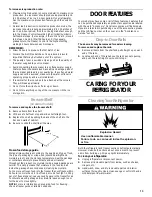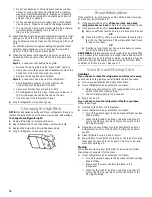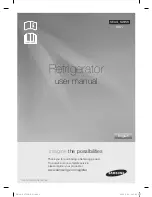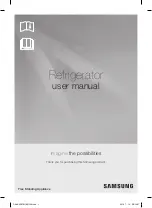
13
To increase ice production rate:
■
Maximum Ice Production (on some models): In maximum ice
production, the ice maker should produce approximately 16
to 20 batches of ice in a 24-hour period. If your refrigerator
has the maximum ice production feature, push the switch to
MAX.
■
Normal Ice Production: In normal ice production mode, the
ice maker should produce approximately 8 to 12 batches of
ice in a 24-hour period. If ice is not being made fast enough,
turn the Freezer Control toward a higher (colder) number in
half number steps. (For example, if the control is at 3, move it
to between 3 and 4.) Wait 24 hours and, if necessary,
gradually turn the Freezer Control to the highest setting,
waiting 24 hours between each increase.
REMEMBER:
■
Allow 24 hours to produce the first batch of ice.
■
Discard the first three batches of ice produced to avoid
impurities that may be flushed out of the system.
■
The quality of your ice will be only as good as the quality of
the water supplied to your ice maker.
■
Avoid connecting the ice maker to a softened water supply.
Water softener chemicals (such as salt) can damage parts of
the ice maker and lead to poor quality ice. If a softened water
supply cannot be avoided, make sure the water softener is
operating properly and is well maintained.
■
It is normal for the ice cubes to be attached at the corners.
They will break apart easily.
■
Do not force the wire shut-off arm up or down.
■
Do not store anything on top of the ice maker or in the ice
storage bin.
Freezer Shelf
(on some models)
To remove and replace the freezer shelf:
1. Remove items from the shelf.
2. Lift back of shelf over stop and slide shelf straight out.
3. Replace the shelf by sliding the back of the shelf into the
tracks on walls of cabinet.
4. Be sure to slide the shelf in all the way.
Frozen food storage guide
Storage times will vary according to the quality and type of food,
the type of packaging or wrap used (should be airtight and
moisture-proof), and the storage temperature. Seal the package
or container securely to prevent taste and odor transfer
throughout the product. Ice crystals inside a sealed package are
normal. This simply means that moisture in the food and air
inside the package have condensed, creating ice crystals.
Put no more unfrozen food into the freezer than will freeze within
24 hours (no more than 2-3 lb of food per cubic foot [907-1,350 g
per L] of freezer space). Leave enough space in the freezer for air
to circulate around packages. Be careful to leave enough room
for the door to close tightly.
NOTE: For more information on preparing food for freezing,
check a freezer guide or reliable cookbook.
DOOR FEATURES
Your model may have some or all of these features. Features that
can be purchased separately as product accessories are labeled
with the word “Accessory.” Not all accessories will fit all models.
If you are interested in purchasing one of the accessories, please
call the toll-free number on the cover or in the "Assistance or
Service" section.
Drop-in Door Rails
The door rails may be removed for easier cleaning.
To remove and replace the rails:
1. Remove all items from the shelf and pull straight up on each
end of the rails.
2. Locate each end of the rail above the rail’s pocket opening,
and push the rail straight down until it stops.
CARING FOR YOUR
REFRIGERATOR
Cleaning Your Refrigerator
Both the refrigerator and freezer sections defrost automatically.
However, clean both sections about once a month to prevent
odors from building up. Wipe up spills immediately.
To clean your refrigerator:
1. Unplug refrigerator or disconnect power.
2. Remove all removable parts from inside, such as shelves,
crispers, etc.
3. Hand wash, rinse, and dry removable parts and interior
surfaces thoroughly. Use a clean sponge or soft cloth and a
mild detergent in warm water.
Explosion Hazard
Use nonflammable cleaner.
Failure to do so can result in death, explosion,
or fire.






































